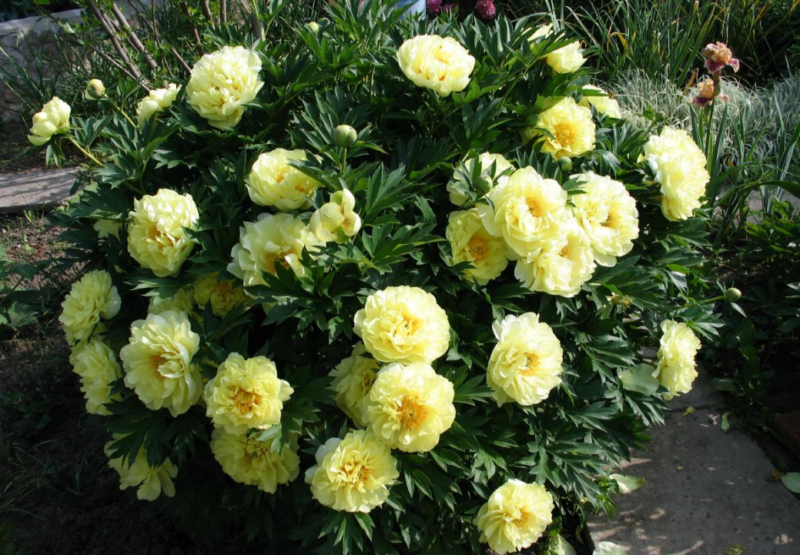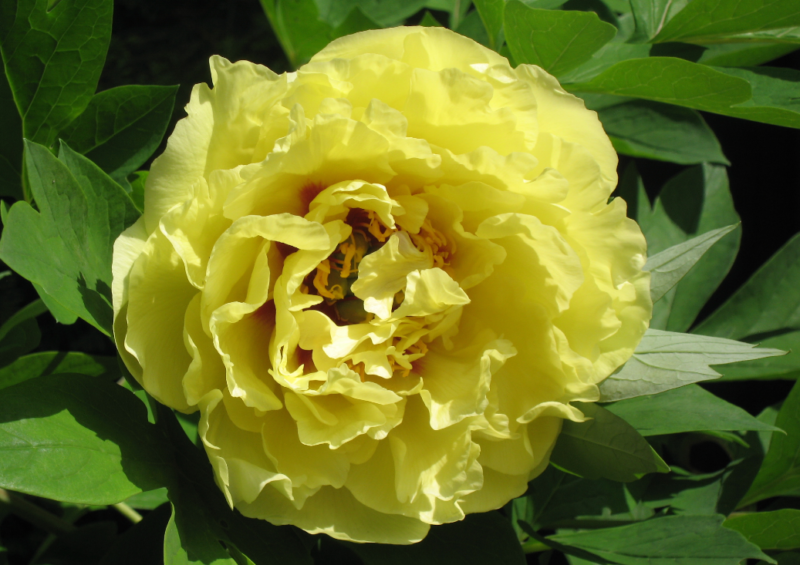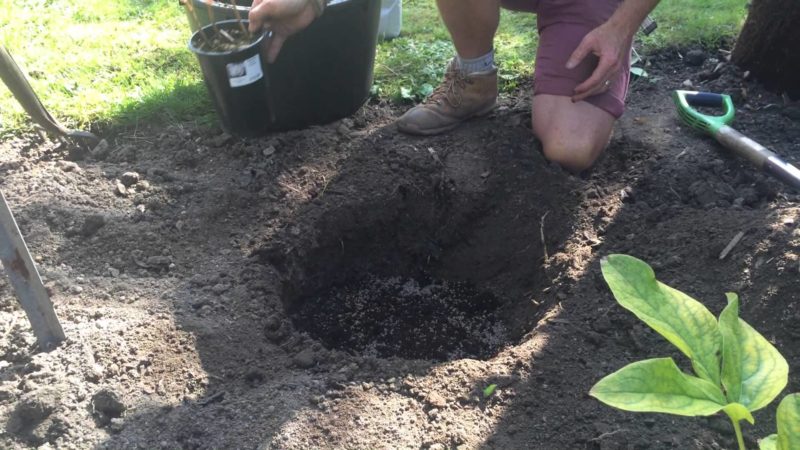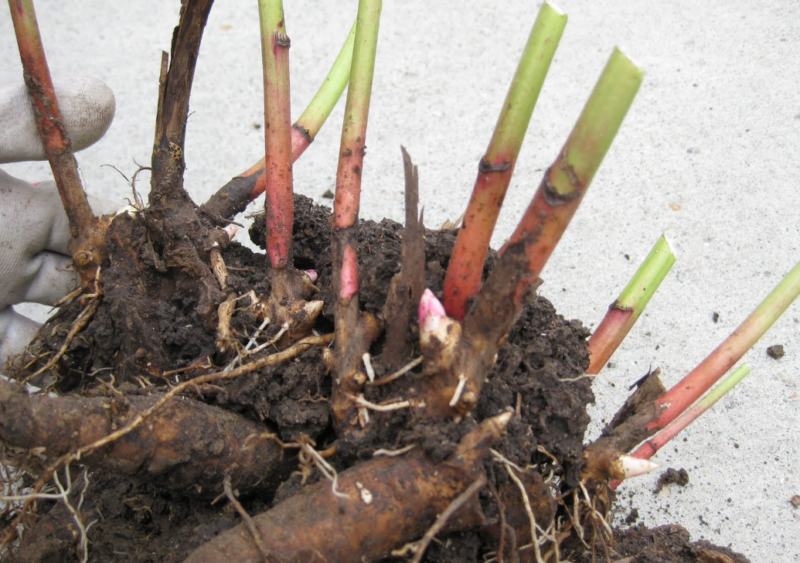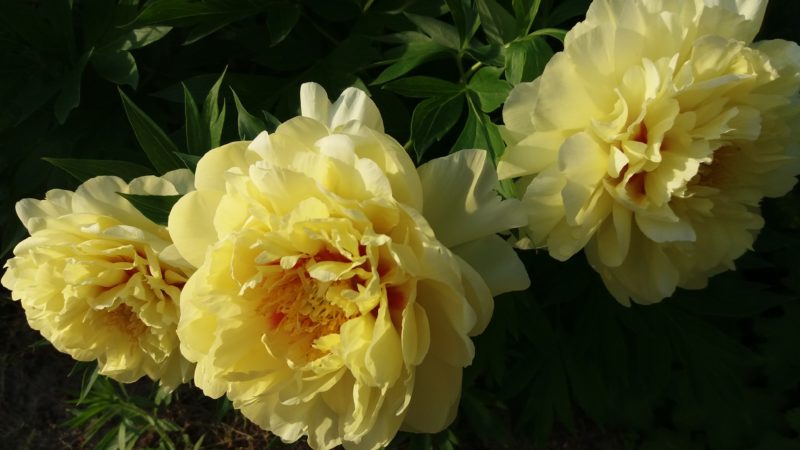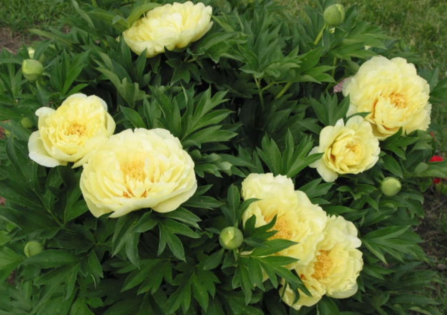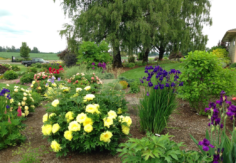In the collection of each grower, there must be a bright representative of decorative plants for the garden - a yellow peony. This magnificent plant will become the main decoration of the spring flowerbed.
Material Content:
Description of species and varieties of yellow peony
Yellow peonies differ primarily in the types of varieties.
It:
- grassy peonies;
- tree-like;
- hybrids.
The most beautiful varieties belong to Ito-hybrids, which look fascinating during flowering. This is Viking Full Moon, blooming in greenish-yellow flowers with a diameter of up to 15 cm. And also Canary Diamond is one of the largest varieties with double flowers. The bush can reach 90 cm, and the size of the blossomed bud is 20 cm in diameter.
The peony yellow “Bartzella” is very popular among flower growers with flowers reaching 25 cm in diameter with tea-yellow shades. Flowering lasts about a month, the plant is very resistant to disease. The bright color of the petals and the stunning aroma attract everyone's attention.
In the gardens you can find a yellow tree-like peony “Golden placer”. The variety blooms very late and adorns the garden in the summer.
Up to 2 meters in height reaches another variety of tree-shaped peonies - "Yellow Yao." The bush is frost-resistant, grows without changes in one place up to 20 years.
In 1958, the first yellow terry peony breeder Toichi Ito was bred in Japan. A grassy yellow and tree-like peony was crossed. The photo clearly shows the luxurious flowers of this plant.
Outdoor landing
Planting a yellow peony begins with the selection of a suitable site. Although the culture is photophilous, it does not tolerate direct sun during the lunch hours.The bush in light partial shade will feel great. In the shade, it is better not to plant a peony, since it is possible that there will be problems with flowering - the flower stalk can be very long, fragile, or the peony refuses to bloom at all.
The place should be well protected from drafts and the north wind, be quite spacious. Peonies should not be planted next to structures or large trees and shrubs. Yellow peony needs a lot of space, as its bushes grow very large and sprawling.
The area where the groundwater lies close is not suitable.
The soil should be loamy, well fertilized.
Culture is best planted in the fall. A minimum step of 70 cm should be left between the bushes. Spacious holes are dug in size much larger than the root system of the seedling. The bottom layer in the hole should consist of compost mixed with peat and rotted manure. If there is loam in the area, you need to add 200 g of lime when planting.
Seedlings of yellow peonies are transplanted with a lump of earth. The roots can not be divided, as young plants do not have time to get stronger before the cold. Plants are covered with fertile soil, watered and necessarily mulched to reduce evaporation of moisture.
How to care for flowers
Care of peonies in the open ground consists in regular watering, top dressing, pruning and weeding. It is also necessary to fight pests and learn to protect the bushes from diseases.
Watering is extremely important during the budding period. They begin to water already in April and continue until the end of August. After flowering, one watering per month is enough.
They feed the culture three times. For the first time, fertilizer is applied after the snow melts. Bushes are watered with a solution of manganese. Then, when the shoots begin to grow, they are fertilized with nitrogen and potassium. You can use rotted manure or potassium salt. Phosphorus fertilizers are added a couple of weeks before flowering.
Once the flower fades, it needs to be cut. The remaining branches do not touch the entire season. During the beginning of bud formation, stepsons on each branch are removed to make the main flower larger.
Preparing for the winter
Before the cold shoots cut off flush with the ground. Then the bushes are sprinkled with sawdust or dry peat. The thickness of the shelter should be at least 10 cm. From above, additionally cover the plant with a wooden box and spruce branches.
Peony propagation methods
All varieties of yellow peonies can be propagated by dividing the rhizome.
This method is the basic and easiest. In the middle zone, bushes can be divided in early May. For division suitable specimens that have reached four years of age.
First, the peony must be dug up from all sides and removed with a shovel or pitchfork from the ground. Then the rhizome is shaken off the ground and divided by a sharp knife into dividers so that there are kidneys on each.
Parts of the rhizome are planted in the holes and watered, necessarily mulched.
Even peonies can be propagated by cuttings, but this method is not so widespread. This process is very troublesome. Usually expensive varieties are propagated by cuttings.
How to keep a yellow peony before planting in the fall
With the onset of the hot summer months, the process of root formation of the peonies is inhibited and the rest phase begins. But by the end of August, when the soil temperature drops to about +15, the root growth resumes again - the autumn phase of growth begins. That’s why autumn is the best time to land.
If the peony was acquired too early, it must be somehow preserved before planting in the ground. Inspect the seedling - if there are signs of decay, they are cut and treated with a disinfecting solution. Normal green is suitable. To delay the time of awakening of the plant, it is wrapped in moss, then in a film, after making holes in it, and kept at a temperature of about +5. You can keep peonies in an ordinary refrigerator until the autumn planting.
Protection against diseases and pests
Of the diseases, gray rot is the most dangerous.If the plant began to fade for no apparent reason in the spring, then, most likely, this disease struck him. As the disease develops, a grayish coating appears on all parts of the bush.
Sick parts of the plant immediately need to be cut off and burned. In winter, the affected peonies are cut very short. In spring, spraying with Bordeaux fluid is carried out.
Another scourge of peonies is rust, which can be easily distinguished by brown or orange spots. Sick leaves should be cut off and the plant sprayed with Bordeaux fluid.
Ants are carriers of diseases and can lead to depletion of buds. You can get rid of insects by spraying with the drug "Fufanon".
It should also be noted that ants will not settle under healthy bushes. The invasion of these insects is a signal that the peony is sick.
On peonies, aphids can parasitize. Insects settle in whole colonies and suck the juice from the buds. Pests can be collected manually or sprayed with a bush with Fitoverm.
Use in landscape design
Each gardener can decorate the garden with these colorful plants. Yellow peonies look amazing against the backdrop of green conifers or in a single landing in the middle of the lawn. The openwork foliage of bushes with long leaves of daylilies and irises goes well.
You can decorate the alley with bushes or plant them in the background of the flower garden. A great place for a fragrant yellow peony is a flower garden next to a bench or swing.
Growing peonies is an exciting experience. Each grower is happy to watch how a luxurious plant with beautiful flowers grows from a small seedling.


